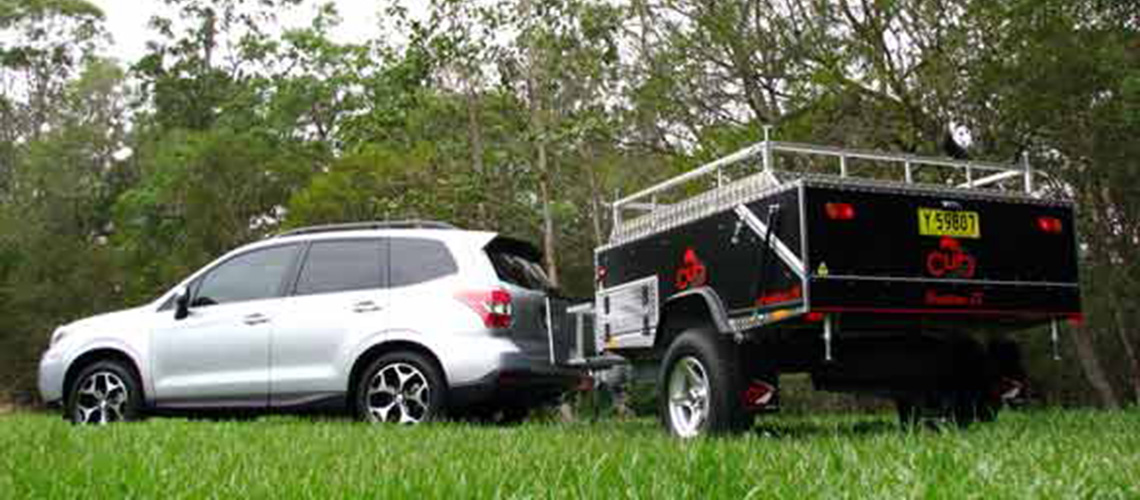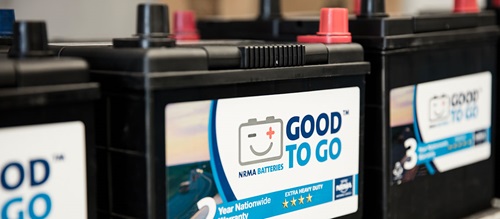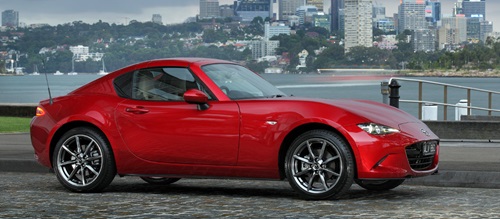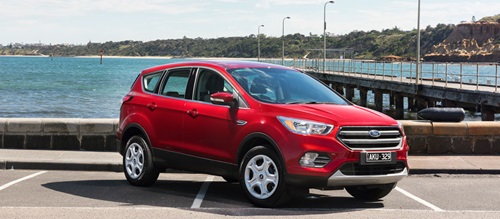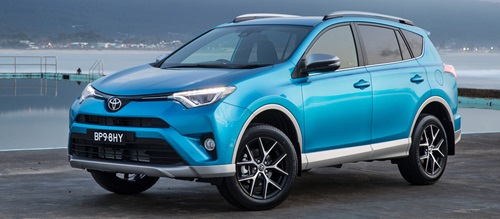Snapshot |
|
| Priced from | $34,590 |
| Engine | 2.0 L |
| Transmission | 6-speed manual |
| Fuel Economy |
8.5L/100km
AVG
|
| Output | 108kW/350Nm |
| ANCAP rating |
|
Why can't the Forester find itself between the trees?
I often wonder when I see a gargantuan 4WD/caravan combination, exactly what the attraction is in something so big and expensive. Sure, you get the equivalent of the penthouse suite at the Ritz to lounge about in at the end of the day, but that's about the only benefit I can see in taking the brontosaurus option. Its least appealing consequence is that you are restricted to the well-worn bitumen tourist trails, where travellers talk longingly about those beautiful, uncrowded places they would really love to stay at for a while if only their rigs weren't too cumbersome, tall, long and heavy to get there.
The minimalist alternative - going cheap, small and light - does involve compromises to comfort and convenience, certainly, but on the road you'll save a fortune, avoid the stress that comes with driving a big rig and your "Where shall we go next?" options will be infinitely greater.
I'm reminded of this taking Subaru's new Forester 2.0-litre turbo diesel, six speed manual, hooked up to a Cub Kamparoo Daintree LE camper trailer, into the Werrikimbe National Park, deep in the Great Dividing Range behind the NSW mid-north coast, terrain that's impossible for large, heavy combinations to traverse. In fact some of the dirt roads in this area have "No Caravans" signs.
The Forester 2.0D starts at $34,590; ours was the top spec S, priced at $43,990. There's no difference in mechanical specification, however the S is lavishly equipped, with metallic paint, a power tailgate, sunroof, 18-inch alloys with a full size spare, eight-way power-adjustable, heated, part leather-wrapped front seats, dual zone air, self-levelling xenon headlights, electric folding rear seats, navigation, and rain-sensing wipers. Not bad value at all for forty-and-a-half large.
The base model isn't exactly poverty pack spec, either, with 17-inch alloys, Bluetooth with voice command and audio streaming, Data Dot identification, a rear camera and dual zone air all standard on the 2.0D.
Our Cub Daintree LE camper, as standard, costs $21,990. It's an off-road model, with a Trigg hitch, stone guard, over-ride disc brakes and independent suspension.
The all-up price of our rig, excluding the factory towbar and fitment, is $67,980. The base model Forester/Cub option comes in at just $56,580. That's great value for a ready to roll combination of two exceptionally well-built, high quality products.
The base Forester weighs 1510kg; the S is 1560kg. It will tow up to 1800kg, with a maximum tow ball download of 180kg. The Cub weighs just 710kg before you load it up and fill the 80-litre tank. Our combined vehicle mass, then, is going to be around 2400-2500kg. They don't come much lighter.
Even so, the Forester isn't a convincing tow vehicle. Subaru has calibrated its 2.0-litre turbo diesel to achieve maximum fuel efficiency. Unladen, it can return less than 7.0L/100km on a highway cruise, however this comes without the bottom end and midrange pulling power you expect in today's 2.0-litre turbo diesel engines. Although its peak torque figure of 350Nm from 1600-2400rpm suggests otherwise, the Subaru unit is weak below 3000rpm or so, and dies a very quick death if you let the revs drop to the point where it's off boost. An imprecise clutch and overly tall gearing do not help its cause once you get past the yawning gap that separates second from third.
I achieved 9-10L/100km towing the Cub up the Pacific Highway from Sydney. On the gentler slopes of the ranges, this rose to 10-12L/100km, then 14L/100km in the steeper sections. I've towed heavier trailers behind much more tractable, stronger 2.0-litre four-cylinder turbo diesels, notably the Land Rover Freelander 2, and achieved comparable fuel figures.
I've also driven the larger Subaru Outback, in which the Forester's engine can now be matched with Subaru's new continuously variable automatic transmission. This is an elegant, efficient compromise, which makes much better use of the engine's performance, especially for towing, and will also return low fuel consumption figures.
When you're gentle on the accelerator the CVT keeps the revs as low as possible and is perfectly smooth. When you hit a serious hill, or use more than 65 per cent throttle, the transmission mimics a refined, responsive seven-speed automatic, with the benefit of a wide ratio spread. You can also shift gears manually, using steering wheel paddles. The CVT will be available in the Forester in 2014. As in the Outback, it will transform the diesel's performance, laden and unladen.
The Cub pushed the Subaru around a little under brakes, but overall it was reasonably stable. With Forester's maximum towing weight of 1800kg on the back, the cart would definitely be trying to overtake the horse. I would also question the durability of the clutch, because you would often have to use slip to get such a heavy load rolling. The rear dampers held up well over some punishing roads; the rear springs, however, are quite light so there was some trailer sag, even with less than 100kg on the tow ball.
Again, the Outback, which has self-levelling rear suspension and a longer wheelbase, would offer more stable, confident towing. It's hardly a heavyweight either, at 1553-1626kg, and the Outback 2.0D CVT is excellent value, from $42,490.
Forester and Outback both have full size spare tyres as standard, for which I am extremely grateful when we get a flat deep in the Werrikimbe. It is quick and easy to unhitch and change wheels - another benefit of choosing small, light touring tackle.
I guess the moral of this story, though, is that when putting a rig together you don't want too little, any more than you need too much.
Cub Kamparoo Daintree LE
Cub's Kamparoo Daintree LE, is an elegant little hard floor camper with genuine off-road capability. It's light enough to tow behind just about any 4WD or SUV on the market, and many cars, too.
A strong, beautifully-crafted chassis (with galvanising optional, however) includes a Trigg hitch, independent trailing axle, coil spring/strut suspension, mechanical override disc brakes, 15-inch alloy wheels with 225/75 Goodyear Wrangler tyres and an underslung, wind-down spare. Standard equipment includes two internal 240V power points and two 12V Merit outlets, plus one external Merit outlet. However there's no on-board power or lighting. A 100ah deep cycle battery system adds $1,130.
The stainless steel kitchen slides out of the front left side and features a two-burner gas stove, hand water pump, two drawers underneath plus pantry storage in an adjacent slide-out compartment. You will have to carry your fridge in your vehicle.
Up front is a big, lockable storage box plus two 4kg gas cylinders, two jerry can holders and a stone guard. An extra two storage lockers are provided, one on either side of the camper. The properly-shielded water tank holds 80 litres.
The Cub's light weight, low stance, Trigg coupling and sophisticated suspension make it a dream to tow. On rough roads in the bush and on the highway it tracked perfectly at speed, didn't get kicked around on bumps and was smooth, stable and secure behind the Forester. The override brakes provided minimal assistance; given the Cub's light weight, it was enough to keep the trailer in line, and prevent shunting, under moderately hard braking.
Velcro and press studs are used to secure the tent to the camper body when you're setting up. They're a bit fiddly, and leave a few small openings through which the dreaded mozzies will inevitably enter. The access door is secured with a zip, velcro and studs, so you'll probably curse its complexity when you're trying to open and close it in the dark. The standard annex is held up by a clever self- supporting frame, so in calm conditions there's no need to peg it out. The queen-size bed has a foam mattress and lifts up on struts for extra storage underneath.
The Cub Kamparoo Daintree LE is ideally suited to two people and would be an excellent choice for all types of touring, from the occasional weekend in a national park to a long outback or desert trip, where the quality of its engineering and its light weight would be great assets.
You would want to supplement its standard features with a deep-cycle battery, though, and, if it's going to be home for extended periods, the extra $4500 for the bells and whistles Brumby model is money well spent.
Fast facts
Manufacturer: Cub Campers
Model: Kamparoo Daintree LE
Price: From $21,990 (inc. on roads, ex. Sydney)
Contact:
Cub Campers
A: 23 Loyalty Road, North Rocks, NSW, 2151
P: 02 8838 8600
W: www.cubcampers.com.au







